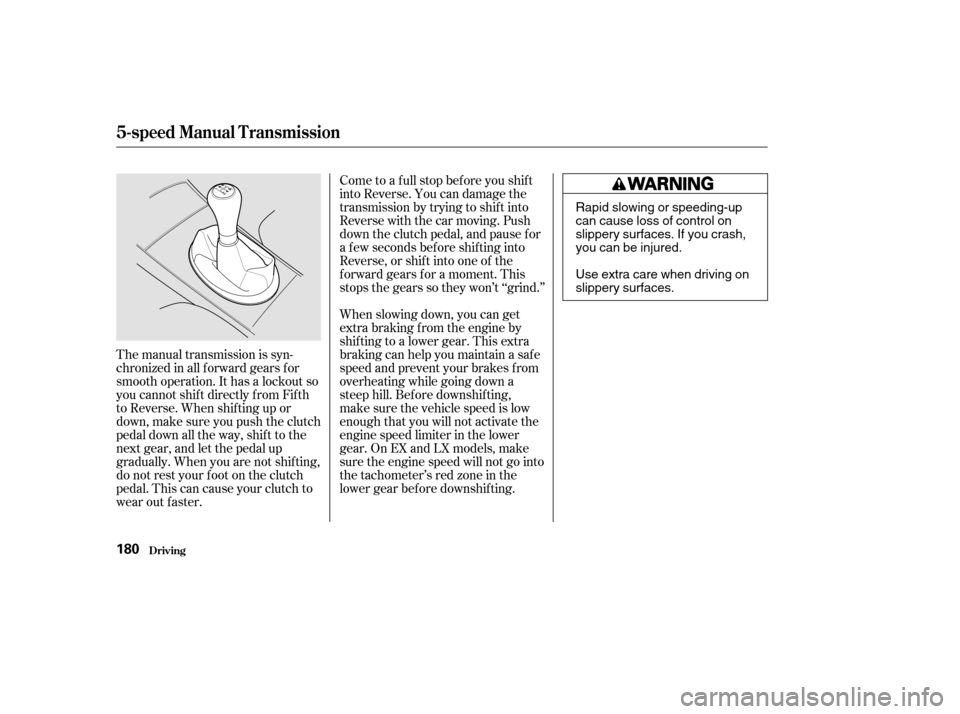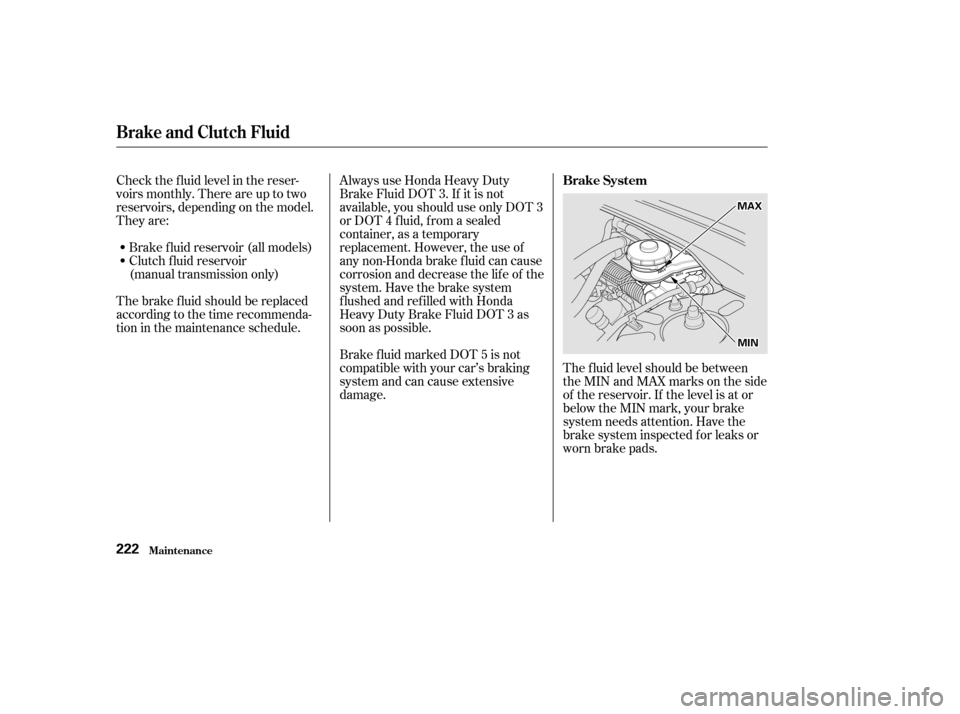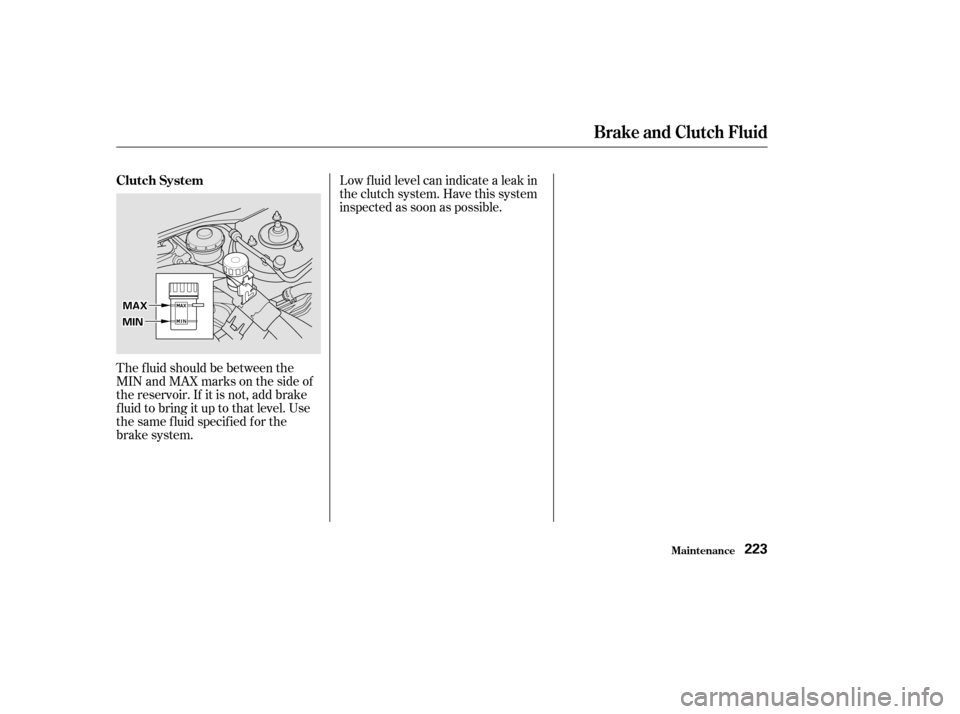2002 HONDA CIVIC clutch
[x] Cancel search: clutchPage 160 of 321

Even with the cruise control turned
on, you can still use the accelerator
pedal to speed up f or passing. Af ter
completing the pass, take your foot
of f the accelerator pedal. The car
will return to the set cruising speed.
Resting your f oot on the brake or
clutch pedal will cause the cruise
control to cancel.
You can decrease the set cruising
speed in any of these ways:
Press and hold the SET/decel
button. The car will decelerate.
Release the button when you
reach the desired speed.
To slow down in very small
amounts, tap the SET/decel
button repeatedly. Each time you
do this, your car will slow down
about 1 mph (1.6 km/h).
Tap the brake or clutch pedal
lightly with your f oot. The
CRUISE CONTROL light on the
instrument panel will go out.
When the car slows to the desired
speed, press the SET/decel button.
The car will then maintain the
desired speed. Tap the brake or clutch pedal.
Youcancancelthecruisecontrolin
any of these ways:
Push the CANCEL button on the
steering wheel.
Press the Cruise Control Master
Switch.
CONT INUED
Cancelling t he Cruise Cont rol
Cruise Control
Comf ort and Convenience Feat ures161
CCAANNCCEELLBBUUTTTTOONN
Page 161 of 321

When you push the CANCEL button,
or tap the brake or clutch pedal, the
CRUISE CONTROL light on the
instrument panel will go out and the
car will begin to slow down. You can
use the accelerator pedal in the
normal way.
The system remembers the
previously-set cruising speed. To
return to that speed, accelerate to
above25mph(40km/h),thenpress
the RESUME/accel button. The
CRUISE CONTROL light comes on,
and the car will accelerate to the
same cruising speed as bef ore.Pressing the Cruise Control Master
Switch turns the system completely
of f and erases the previous cruising
speed f rom memory. To use the
system again, ref er to
.
Cruise Control
Comf ort and Convenience Feat ures
Using t he
Cruise Cont rol
162
Page 178 of 321

If the engine does not start within
15 seconds, or starts but stalls
right away, repeat step 4 with the
accelerator pedal pressed half-way
down. If the engine starts, release
pressure on the accelerator pedal
so the engine does not race.
If the engine still does not start,
press the accelerator pedal all the
way down and hold it there while
starting in order to clear f looding.
As bef ore, keep the ignition key in
the START (III) position f or no
more than 15 seconds. Return to
step 5 if the engine does not start.
If it starts, lif t your f oot of f the
accelerator pedal so the engine
does not race.
Apply the parking brake.
In cold weather, turn of f all
electrical accessories to reduce
the drain on the battery.
Push the clutch pedal down all the
way. START (III) does not
f unction unless the clutch pedal is
depressed.
Make sure the shif t lever is in
Park. Press on the brake pedal.
Without touching the accelerator
pedal, turn the ignition key to the
START (III) position. If the engine
does not start right away, do not
hold the key in START (III) f or
more than 15 seconds at a time.
Pause f or at least 10 seconds
bef ore trying again. An engine is harder to start in cold
weather. The thinner air f ound at
high altitude above 8,000 f eet (2,400 meters) adds to the problem.
Use the f ollowing procedure:
Turn of f all electrical accessories
to reduce the drain on the battery.
Push the accelerator pedal half-
way to the f loor and hold it there
while starting the engine. Do not
hold the ignition key in START
(III) f or more than 15 seconds.
When the engine starts, release
the accelerator pedal gradually as
the engine speeds up and smooths
out.
If the engine fails to start in step 2,
push the accelerator pedal to the
f loor and hold it there while you
try to start the engine for no more
than 15 seconds. If the engine
does not start, return to step 2.
1. 2. 3. 4.
5. 6.
1. 2. 3.
Manual Transmission:
Automatic Transmission:
Starting the Engine
Driving
Starting in Cold Weather at High
A ltitude (A bove 8,000 f eet/
2,400 meters)
179
Page 179 of 321

The manual transmission is syn-
chronizedinallforwardgearsfor
smooth operation. It has a lockout so
you cannot shift directly from Fifth
to Reverse. When shif ting up or
down,makesureyoupushtheclutch
pedal down all the way, shift to the
next gear, and let the pedal up
gradually. When you are not shif ting,
do not rest your f oot on the clutch
pedal. This can cause your clutch to
wear out faster.Come to a full stop before you shift
into Reverse. You can damage the
transmission by trying to shif t into
Reverse with the car moving. Push
down the clutch pedal, and pause f or
a f ew seconds bef ore shif ting into
Reverse, or shif t into one of the
f orward gears f or a moment. This
stops the gears so they won’t ‘‘grind.’’
When slowing down, you can get
extra braking f rom the engine by
shifting to a lower gear. This extra
braking can help you maintain a safe
speed and prevent your brakes f rom
overheating while going down a
steep hill. Bef ore downshif ting,
make sure the vehicle speed is low
enough that you will not activate the
engine speed limiter in the lower
gear. On EX and LX models, make
sure the engine speed will not go into
the tachometer’s red zone in the
lower gear bef ore downshif ting.
5-speed Manual T ransmission
Driving180
Rapid slowing or speeding-up
can cause loss of control on
slippery surfaces. If you crash,
you can be injured.
Use extra care when driving on
slippery surfaces.
Page 194 of 321

This section also includes
Maintenance Schedules f or normal
driving and severe driving conditions,
a Maintenance Record, and instruc-
tions f or simple maintenance tasks
you may want to take care of
yourself .
If you have the skills and tools to per-
f orm more complex maintenance
tasks on your Honda, you may want
to purchase the Service Manual. See
page f or inf ormation on how to
obtain a copy, or see your Honda
dealer.
This section explains why it is
important to keep your car well
maintained and to f ollow basic
maintenance saf ety precautions.
......................
Maintenance Saf ety . 196
.
Important Safety Precautions . 197
.................
Maintenance Schedule . 198 ...
Required Maintenance Record . 205
.......
Owner Maintenance Checks . 207
..............................
Fluid Locations . 208
......................................
Engine Oil . 209
..................................
Adding Oil . 209
....................
Recommended Oil . 209
..............................
Synthetic Oil . 210
....................................
Additives . 210
.....
Changing the Oil and Filter . 211
.............................
Cooling System . 213
............
Adding Engine Coolant . 213
.......
Replacing Engine Coolant . 215
....................
Windshield Washers . 219
.......................
Transmission Fluid . 220
Automatic .........................
Transmission . 220
5-speed Manual .........................
Transmission . 221
................
Brake and Clutch Fluid . 222
............................
Brake System . 222
...........................
Clutch System . 223
..............................
Power Steering . 224
.....................
Air Cleaner Element . 225
....................................
Hood Latch . 226
....................................
Spark Plugs . 227
..............................
Replacement . 227 ............................
Specif ications . 229
...........................................
Battery . 230
.................................
Wiper Blades . 232
..............
Air Conditioning System . 234
..................
Dust and Pollen Filter . 235
.....................................
Drive Belts . 237
....................................
Timing Belt . 237
...............................................
Tires . 238
......................................
Inf lation . 238
Recommended Tire Pressures ...........
f or Normal Driving . 239
Tire Pressure Adjustment f or ..........
High Speed Driving . 239
..................................
Inspection . 240
..............................
Maintenance . 240
.............................
Tire Rotation . 241
...
Replacing Tires and Wheels . 242
......................
Wheels and Tires . 243
..........................
Winter Driving . 243
.............................
Snow Tires . 243
............................
Tire Chains . 244
.............................................
Lights . 245
.....................
Headlight Aiming . 247
........................
Replacing Bulbs . 247
...........................
Storing Your Car . 256
311
Maintenance
Maint enance195
Page 221 of 321

The f luid level should be between
theMINandMAXmarksontheside
of the reservoir. If the level is at or
below the MIN mark, your brake
system needs attention. Have the
brake system inspected f or leaks or
worn brake pads.
Always use Honda Heavy Duty
Brake Fluid DOT 3. If it is not
available, you should use only DOT 3
or DOT 4 f luid, f rom a sealed
container, as a temporary
replacement. However, the use of
any non-Honda brake fluid can cause
corrosion and decrease the lif e of the
system. Have the brake system
f lushed and ref illed with Honda
Heavy Duty Brake Fluid DOT 3 as
soon as possible.
Check the f luid level in the reser-
voirs monthly. There are up to two
reservoirs, depending on the model.
They are:
Brake f luid reservoir (all models)
Clutch f luid reservoir
(manual transmission only)
Brake f luid marked DOT 5 is not
compatible with your car’s braking
system and can cause extensive
damage.
The brake f luid should be replaced
according to the time recommenda-
tion in the maintenance schedule.
Brake and Clutch Fluid
Maint enance
Brake System
222
MMAAXX
MMIINN
Page 222 of 321

The f luid should be between the
MIN and MAX marks on the side of
the reservoir. If it is not, add brake
f luid to bring it up to that level. Use
the same f luid specif ied f or the
brake system.Low f luid level can indicate a leak in
the clutch system. Have this system
inspected as soon as possible.
Brake and Clutch Fluid
Maint enance
Clutch System
223
MMAAXX
MMIINN
Page 271 of 321

Diagnosing why your engine won’t
start f alls into two areas, depending
on what you hear when you turn the
key to START (III):When you turn the ignition switch to
START (III), you do not hear the
normal noise of the engine trying to
start. You may hear a clicking sound
or series of clicks, or nothing at all.
Check these things:
You hear nothing, or almost
nothing. The engine’s starter
motor does not operate at all, or
operates very slowly.
You can hear the starter motor
operating normally, or the starter
motor sounds like it is spinning
f aster than normal, but the engine
does not start up and run. Check the transmission interlock.
If you have a manual transmission,
the clutch pedal must be pushed
all the way to the f loor or the
starter will not operate. With an
automatic transmission, it must be
in Park or Neutral.
Turn the ignition switch to ON (II).
Turn on the headlights and check
their brightness. If the headlights
are very dim or don’t light at all,
the battery is discharged. See
on page . Turn the ignition switch to START
(III). If the headlights do not dim,
check the condition of the f uses. If
the f uses are OK, there is proba-
bly something wrong with the
electrical circuit f or the ignition
switch or starter motor. You will
need a qualif ied technician to
determine the problem. (See
on page .)
If the headlights dim noticeably or
go out when you try to start the
engine, either the battery is dis-
charged or the connections are
corroded. Check the condition of
the battery and terminal connec-
tions (see page ). You can
then try jump starting the car from
a booster battery (see page ). 290
230 274
274
If Your Engine Won’t Start
T aking Care of t he Unexpect ed
Nothing Happens or the Starter
Motor Operates Very Slowly
Jump Starting Emergency T owing
272